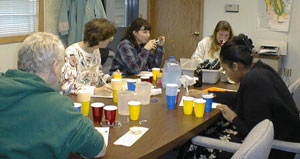Tastes and Odors (T&O)
|
A 1989 survey conducted by the American Water Works Association on water systems throughout the country found three predominant causes of taste and odor problems:
What is Seattle Public Utilities doing to minimize T&O occurrences? SPU closely monitors all taste and odor problems reported in addition to performing flavor profile analyses on a regular basis. Flavor profile analysis uses a group of trained panelists to identify flavors and/or aromas in raw and treated waters. Seattle Public Utilities has recognized an algal caused taste and odor problem and has initiated several studies to control the problem. An ozonation plant at the Lake Youngs outlet is scheduled to go on line in 2004; this treatment process has demonstrated 100% effectiveness in pilot scale testing for removing taste and odor problems associated with algal growth. What can be done at home to reduce T&O ? Current taste and odor problems can be reduced at home by adding a drop or two of lemon to a glass or pitcher of water and/or chilling the water before drinking. If aesthetics continue to be a problem, you can consider a home filter. Who should I call if I experience T&O? Whenever your think your water has an unusual taste or odor, call the Highline Water District Office at (206) 824-0375 and speak to Mike Becker, our Water Quality Coordinator at ext. 111. |
